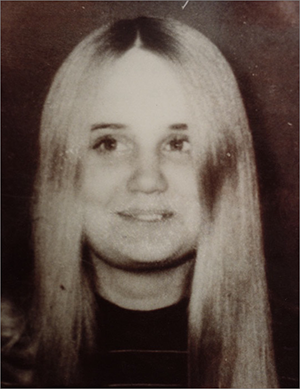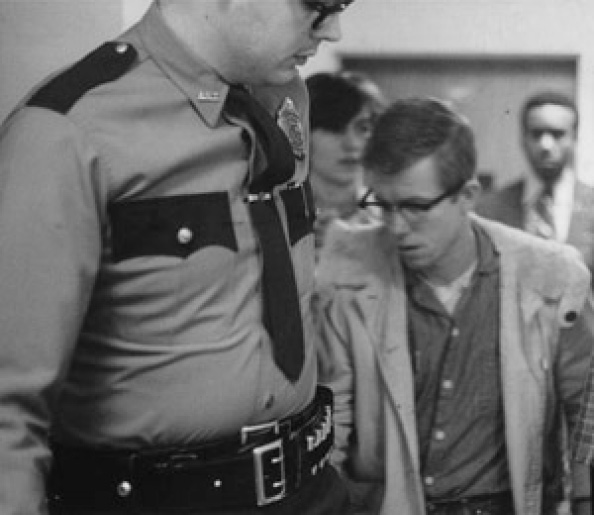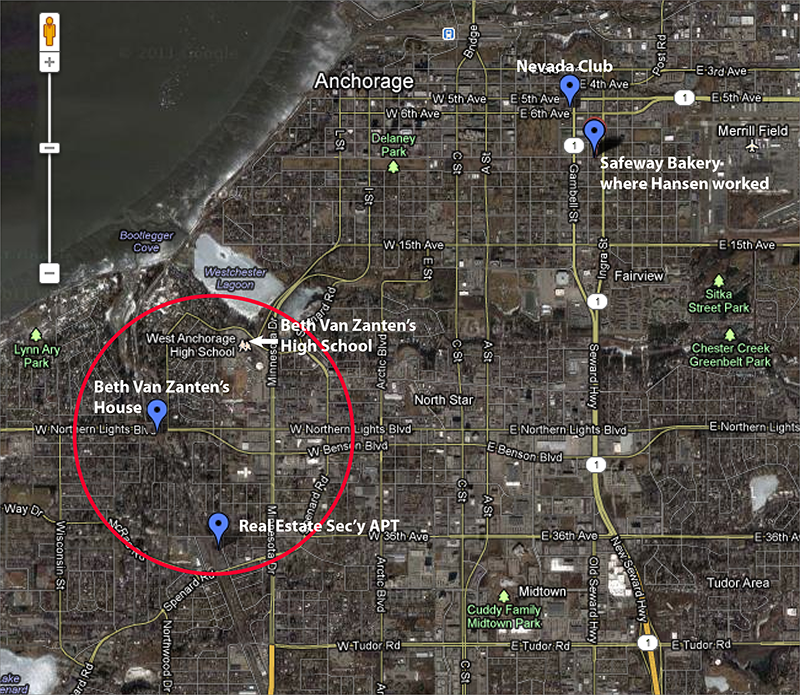Sgt. Walter Gilmour of the Alaska State Troopers was just finishing the last knot in his tie when the phone rang. He was fresh from the shower – after a day of cross-country skiing with his family – and on his way to his in-law’s house for Christmas dinner.
“Sgt. Gilmour, this is dispatch,” the female voice said, detached and professional. “We have been advised that a woman has been found dead in McHugh Creek campground. Patrol is on the way, sir, but we wanted to alert you.”
Christmas dinner would have to wait.
Troopers soon learned that a woman named Celia “Beth” Van Zanten had gone missing on December 23rd. Just 18 years old, she was on her way to a local convenience store when she disappeared. At the crime scene, they found a woman who seemed to match the description: young, fair complexion, long blonde hair. In the days since she’d gone missing, temperatures ranged from a low of minus five to a high of 22. She had frozen to death.

Beth Van Zanten
In the parking lot they found a collage of tire prints spinning in lazy, concentric circles. With the rain starting to drizzle, Gilmour wanted to grab the tire prints as quickly as possible, knowing there was nothing that could cast water. He watched dismally as the evidence melted before his eyes. They ended up taking photographs instead.
Their scene search, meanwhile, turned up a silver belt buckle and, later, a black leather belt. In the snow, near the body, investigators also found tufts of yellow tissue paper. That was all they ever found.
That night, Sgt. Gilmour found himself back at the McHugh Creek parking lot on patrol, just as a partially clad young woman made a break from a shadowy figure who was about to bring her down. “Halt, asshole,” the sergeant screamed.
The suspect didn’t halt, but overtook the young woman and started to rape her.
“You son of a bitch, I’ll kill you,” Gilmour cried as he grabbed the assailant by the neck and started to choke him. His hands went completely through the rapist’s neck and were covered in blood.
Their next move was to canvass Beth’s neighborhood and interview family members. Everyone they spoke to offered statements that were soon contradicted. Her brothers seemed to be stoners, who barely noticed Beth’s comings and goings. Their “best” suspect was Greg, her Alaska Native foster cousin, who lived with the family and was said to have a fractious relationship with the victim.
Out clubbing and drinking the night Beth disappeared, Greg had allegedly arranged for her to babysit for one of his friends. His accounts of his whereabouts that night ranged from vague to imprecise, though he was rarely alone during a long night of carousing. Worse yet, although Greg claimed to have talked to Beth – at her house, on the night of her disappearance, to ask about babysitting – her brothers said they never saw him.
The most anyone could say with certainty about Beth’s foster cousin was that he was drunk that night. So drunk that Anchorage Police eventually stopped him, and his friends, and made them take a cab home.
Neighborhood witnesses, meanwhile, reported seeing Beth as late as 11:00 the night she disappeared. She was hitchhiking. Some of Gilmour’s investigators thought that was precisely what this was. A hitchhike-type case. Greg was eventually cleared by a polygraph; Gilmour still thought him the most likely culprit, but the likelihood grew increasingly remote.
The sergeant worried the case for 24 hours straight before getting their first break. He was at his makeshift office in a trailer, the schoolroom clock nearing 21:00 hours.
The place was silent, nearly empty.
Then, suddenly, a sound.
“Sgt. Gilmour,” came the intercom. “Line two.”
On the other end of the line was a senior officer in the troopers. J.P. was one of the first Alaska Natives to join the troopers, a man whose exploits in rural Alaska were legendary. When he called, you listened.
“Hey, look,” he said. “I’ve been hearing about that dead girl down to McHugh Creek. I think I got an informant that may be able to help you.” J.P. told Gilmour that the informant might have been working the street. Gilmour said he’d talk to anyone; only later did he learn that the informant was the trooper’s daughter.
Robyn Patterson [Patty Roberts] was 18 and working the streets to pay for her heroin habit. She told Sgt. Gilmour that on the night of December 19th, she was in the parking lot of the Nevada Club when she was kidnapped at gunpoint by a man who said he’d kill her if she didn’t do what he wanted. She described him in detail. Between 23 and 28 years old. Probably 5’ 8” or 5’ 9”. Slender. Wearing horn-rimmed glasses.

Robert Hansen, Anchorage Courthouse, 1972. He was there to answer Assault with a Deadly Weapon charges against a real estate secretary.
After binding her hands with leather shoelaces, he drove her south on the Seward Highway. Along the way, he kept pulling off the road, telling her he wanted to make love to her. He tried to kiss her. Made her strip down so she couldn’t escape. Said he wanted to slash her bra with his knife.
She kept telling him, “No, I don’t want to do it in the car.”
He finally got a motel, deep into the Kenai Peninsula at Cooper Landing. They tried to have sex, but he failed his orgasm. He expected her to fight, just like the other girls had. On the way back to Anchorage, he threatened to kill her if she ratted him out. Once, he drove her deep into the wilderness, and she had to talk him back.
In those days before computers, cops had what they called the “asshole book,” with photos of every pervert and predator they’d come across. Robyn scanned it page-by-page and column-by-column. “That’s it,” she finally said. “That’s him.”
“Him” was Robert C. Hansen, later known as the “Butcher, Baker.” Gilmour learned that he’d been arrested barely a month before on the Assault with a Deadly Weapon charge involving the real estate secretary. When he kidnapped Robyn, he was out on his own recognizance, awaiting trial for the November incident. This man had no shame. Robyn, meanwhile, was ready to speak her piece.
“You know,” she said, “I may be doing something that some people don’t think is totally acceptable, and it may not be. But that’s not why I’m here. I’m here because that Robert Hansen guy is probably a premeditated, cold-blooded killer, who has killed before.”
Robyn stubbed out her cigarette with force before continuing.
“He said he killed before, and everything he said was absolutely true. Everything he said he would do to me came true, everything he said he would do, he did. Every threat he made, I believed. And if he says he’s killed people, I believe he’s killed people. And if you’ve got a young girl who’s been killed around the same time and in the same area, then I believe it was Hansen who killed her. I believe he’ll kill me, too.”
Hansen steadfastly denied his involvement in the death of Celia “Beth” Van Zanten. The similarities between her abduction and Robyn’s are worth noting: they were taken to the same area, their hands bound; they were stripped to prevent escape, their bras slashed (or threatened to be); they were sexually assaulted. It is also worth noting that Beth Van Zanten’s house was within a mile of the real estate secretary’s apartment. Hansen had cruised that area before.

Anchorage locations mentioned in this post
Robert Hansen was charged in Anchorage Superior Court with Assault with a Deadly Weapon for the attempted abduction of the real estate secretary. He was charged with Rape, Kidnapping and Assault with a Deadly Weapon in the Robyn Patterson case. On March 24, 1972, the Patterson case was dismissed in exchange for a no contest plea on the attempted abduction.
Hansen was ultimately convicted and sentenced to five years imprisonment. He was transferred to a halfway house on June 17, 1972, and placed on work release from that facility. He was paroled on November 1, 1973. His criminal career was far from over. In fact, one could say it was just beginning.
Does anyone know the serial# of the Mini-14 he used?
Hmmm… I’ll check my records.